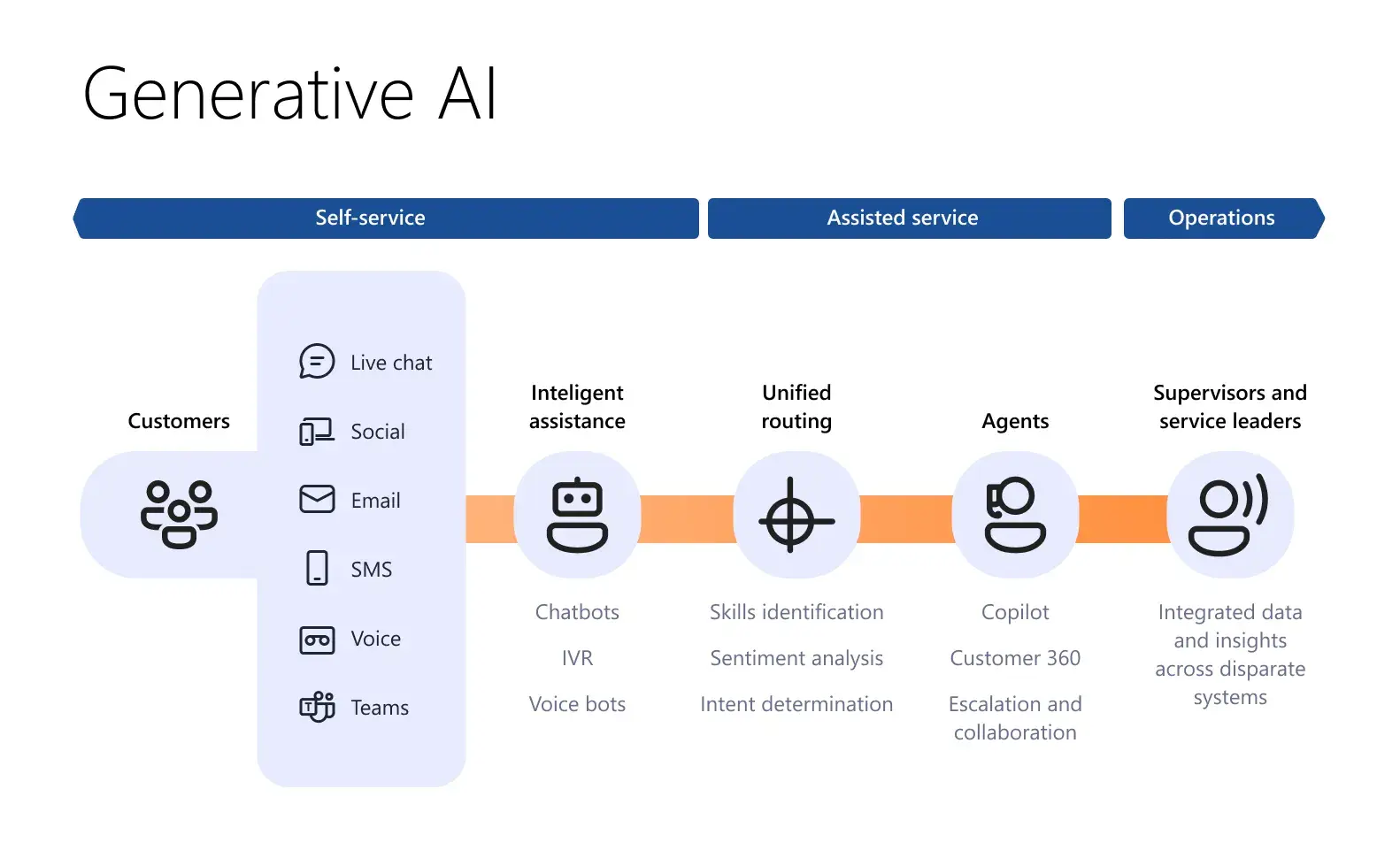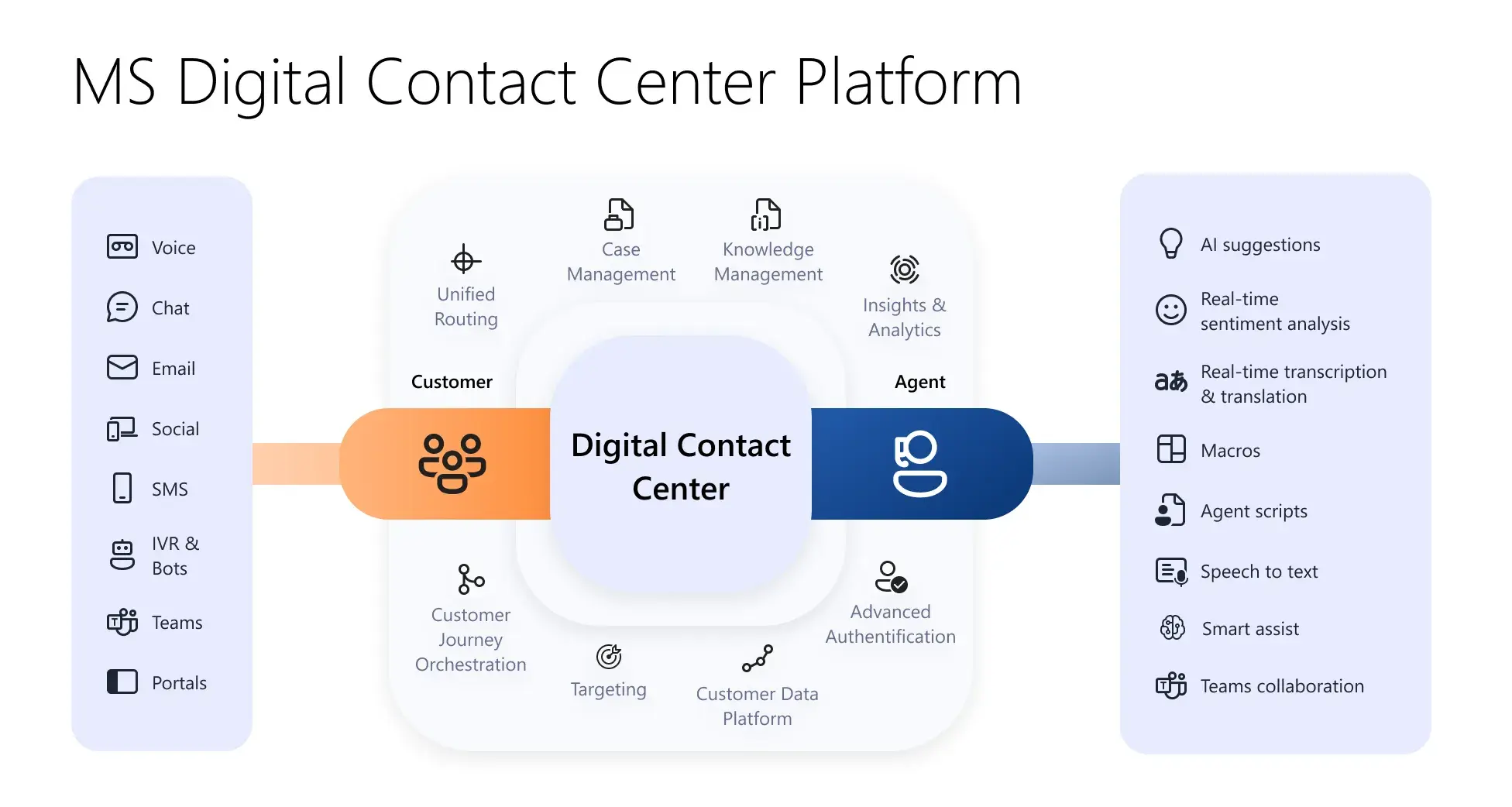Introduction
In today’s swift-paced, customer-oriented business landscape, delivering smooth and personalized service experiences is vital. Enterprises need modern tools that go beyond handling support tickets. In short, they need intelligent, scalable, and unified customer engagement platforms. Microsoft Dynamics 365 Contact Center, connected to Dynamics 365 Customer Service, is designed to meet this challenge by combining AI, omnichannel communication, and seamless integration with the Microsoft ecosystem.
In this article, we will examine the Contact Center's roadmap installation stages and explore the benefits the Center offers its users.
What Microsoft Dynamics 365 Contact Center is
The Contact Center is a service solution with a modern workspace and an inbox-first approach. It is built from the ground up, featuring unified AI, Power Platform workflows, and deep system integration.
Recently Dynamics 365 Contact Center became Microsoft’s Copilot-first Contact Center as a Service (CCaaS), combining generative AI, voice tech, and seamless CRM interoperability via Azure.
The Difference between the Contact Center and the Customer Service Workspace
Users often take the Contact Center and the Customer Service Workplace as one and the same. However, it is wrong to perceive them this way.
Dynamics 365 Contact Center is an all-in-one, AI-powered platform for customer service and support. It includes the Customer Service Workspace as one of its vital functionalities.
The Customer Service Workspace is a multisession desktop interface for case agents, offering basic Copilot support and agent productivity tools. They are both part of the Microsoft Dynamics 365 Customer Service ecosystem, designed for different use cases and levels of complexity.
However, the Customer Service Workspace typically refers to the desktop environment, tools, and interface that agents use to handle customer interactions efficiently across voice, chat, email, and other channels.
The Contact Center Implementation Roadmap
The implementation process does not require as much effort and skills as it may seem, although it is always reasonable to turn to professionals for such a service to save time and money.
Here is a consistent plan to develop and implement a D365 contact center:
Phase 1. Planning
- Define contact center goals (channels, SLAs, compliance).
- Assess the existing Microsoft 365 and Teams integration.
- Identify the use cases for AI, self-service, and automation.
Phase 2. The core setup
- Set up Customer Service workspace and entities (cases, queues).
- Enable omnichannel chat, email, and voice with ACS.
- Configure IVR and the call routing logic.
Phase 3. AI and automation
- Deploy Microsoft Copilot and train the agents in its use.
- Build Power Automate flows, such as case escalation or SLA tracking.
- Configure the knowledge base and the virtual agents.
Phase 4. Testing and rollout
- Pilot with 10–20 agents and gather feedback.
- Fine-tune routing, analytics dashboards, and UI.
- Carry out full deployment with agent onboarding and documentation.
Phase 5. Optimization and scaling
- Introduce new channels, like messengers and SMS.
- Regularly review the performance (CSAT, AHT).
- Expand automation and AI as needed.
The Undeniable Benefits of the Contact Center
Microsoft Dynamics 365 Contact Center offers a comprehensive, AI-powered platform for customer service and support. It empowers the combination of CRM capabilities with communication tools, automation, and analytics to deliver a smooth and practical customer service experience.

There are several weighty reasons to choose Dynamics 365 Contact Center for your organization:
- Unified omnichannel capabilities
Modern customers expect to connect with brands on their preferred channel, whether that’s voice (telephony and Teams phone integration), live chat, email, SMS, or social media. Dynamics 365 Contact Center unifies all these touchpoints into a single, streamlined interface.
Agents can view complete interaction histories, switch between channels without losing context, and deliver consistent, high-quality support. This omnichannel approach considerably enhances customer satisfaction and boosts agent productivity.

- Superior agent and customer experiences
The platform offers a modern, unified agent desktop that consolidates customer data, interaction history, and tools into a single view, thereby reducing screen switching and manual effort.
Customers also benefit from self-service capabilities, such as virtual agents and rich knowledge bases, which enable them to find answers faster and reduce their reliance on live support.
- Built-in AI and Microsoft Copilot
AI is no longer a luxury but a necessity for modern contact centers. Dynamics 365 Contact Center features Copilot, Microsoft’s AI assistant, which supports agents with real-time suggestions, conversation summaries, and knowledge base prompts.
Agents, such as the Case Management Agent, the Customer Knowledge Management Agent, or the Customer Intent Agent, can reduce response times, eliminate repetitive tasks, and make smarter decisions with AI-driven insights, allowing users to focus more on customer empathy and problem-solving.
Furthermore, virtual agents and chatbots, AI-generated summaries, and sentiment analysis in email, as well as the knowledge base, allow customers to resolve issues without live agents via bots and self-help portals. Additionally, Copilot Studio–powered Conversational IVR enables self-service voice conversations with voice bots. Plus, there is the opportunity to integrate customer portals.
- Organic integration with the Microsoft ecosystem
One of the platform’s most powerful advantages is its native integration with other Microsoft tools like Teams, Outlook, Power Platform, and Azure, so users can utilize Teams for internal collaboration directly within the contact center dashboard, leverage Power Automate to build workflows that eliminate manual handoffs, and tap into Power BI for custom analytics and dashboards that offer actionable insights.
Overall, these integrations create a frictionless, productivity-enhancing environment for both agents and supervisors.
- Routing
This functionality determines how incoming interactions, such as calls, chats, or emails, are assigned to agents and redirects each request to the most suitable agent based on predetermined rules. The Contact Center delivers an advanced routing engine that works across all channels (voice, chat, digital messaging). It utilizes AI and machine learning to assess agent availability, skills, and workloads, and routes cases or interactions with agents possessing the right skill set (language, product knowledge). It also defines how different channels are processed and helps balance workloads by assigning work based on available agent capacity.
With this feature, admins can define rules to determine the route based on case type, customer info, or other attributes.
- Case management
It refers to tracking and handling customer issues or requests from creation to resolution. Cases are automatically created from customer interactions (email, chat, portal, phone), but they can also be created manually by agents. Additionally, cases can be linked to contacts, accounts, activities, emails, and entitlements.
Agents can search for or suggest relevant knowledge base articles. They help users track the status (New, In Progress, On Hold, Resolved, Closed), whereas SLAs (Service Level Agreements) ensure timely responses and resolution.
- Customization and flexibility
Every organization has unique needs, and Dynamics 365 Contact Center recognizes that with its low-code/no-code capabilities via Power Apps. Companies can tailor user experiences, build custom dashboards, and automate workflows without heavy reliance on IT.
What is more, the platform is highly scalable, which makes it appropriate for everything from small customer support teams to large, global contact centers.
- Advanced analytics and real-time reporting
Realizing how your Contact Center performs is vital. The Contact Center includes robust reporting tools, real-time dashboards, and AI-driven analytics that track KPIs such as customer satisfaction (CSAT), average handle time (AHT), and first contact resolution (FCR).
Built-in AI can even analyze customer sentiment and identify trends in real-time, empowering supervisors to make data-driven decisions more quickly.
- Enterprise-grade security and compliance
Built on Microsoft’s trusted cloud infrastructure, Dynamics 365 Contact Center offers industry-leading security, compliance, governance, and role-based access control. It supports major standards like GDPR, HIPAA, and ISO, making it suitable for regulated industries such as healthcare, finance, and government.
- Fast deployment and global reach
Thanks to its cloud-native architecture and Microsoft Azure backbone, organizations can quickly deploy the solution across regions, ensuring consistent service quality and scalability. Prebuilt templates, guided setup, and flexible licensing models help reduce time to value.
- Cloud-native structure
The Contact Center allows users to deploy faster with prebuilt templates and the cloud-native architecture. Besides, it offers reliable performance and availability worldwide with Azure infrastructure.
Conclusion
Thus, Microsoft Dynamics 365 Contact Center is a reasonable investment for any business that transforms customer service from a reactive function into a proactive, data-driven experience.
For organizations already invested in the Microsoft ecosystem or those seeking a unified, intelligent platform that scales, Dynamics 365 Contact Center provides a future-ready solution that empowers agents, delights customers, and drives operational excellence, giving them improved and faster customer service, supporting 360-degree customer engagement, better personalization within customer service, enhanced customer satisfaction, increased team productivity, updated unified software and great integration across business units, better operational efficiency, and extensive real-time analytics with business insights and sentiment analysis.

